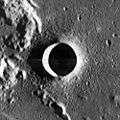Taruntius (crater)
|
Apollo 15 mapping camera image | |
| Coordinates | 5°36′N 46°30′E / 5.6°N 46.5°ECoordinates: 5°36′N 46°30′E / 5.6°N 46.5°E |
|---|---|
| Diameter | 56 km |
| Depth | 1.0 km |
| Colongitude | 314° at sunrise |
| Eponym | Lucius Taruntius Firmanus |



Taruntius is a lunar crater on the northwestern edge of Mare Fecunditatis. To the northwest is the lava-flooded crater Lawrence, and to the north lie the craters Watts and da Vinci. The surface about Taruntius has an unusual number of ghost craters and lava-flooded features, especially to the southwest in the Mare Fecunditatis.
The outer rim of Taruntius is shallow, but forms a veined, complex rampart in the nearby mare, especially to the north and southwest. The rim is broken in the northwest by the small crater Cameron. The inner rim face lacks terraces, but in the interior is an unusual concentric inner rim that is heavily worn and irregular. This is a floor-fractured crater, possibly created by an uplift of mare material from beneath the interior. There is a low central peak complex in the middle of the relatively flat interior floor. There are also some slender rilles that are concentric to the rim.
The crater has a pair of faint dark patches. One patch is located just south of the central peak and the other falls on the sides of the northern rim near Cameron. These were likely created by deposits of volcanic ash from small vents. Taruntius has a ray system with a radius of over 300 kilometers. Due to these rays, Taruntius is mapped as part of the Copernican System.[1]
Satellite craters
By convention these features are identified on lunar maps by placing the letter on the side of the crater midpoint that is closest to Taruntius.
| Taruntius | Latitude | Longitude | Diameter |
|---|---|---|---|
| B | 3.3° N | 46.6° E | 7 km |
| F | 4.0° N | 40.5° E | 11 km |
| H | 0.3° N | 49.9° E | 8 km |
| K | 0.6° N | 51.6° E | 5 km |
| L | 5.5° N | 44.4° E | 14 km |
| O | 2.2° N | 54.3° E | 7 km |
| P | 0.1° N | 51.6° E | 7 km |
| R | 6.1° N | 47.9° E | 5 km |
| S | 4.9° N | 42.4° E | 5 km |
| T | 3.4° N | 47.5° E | 10 km |
| U | 5.6° N | 50.1° E | 12 km |
| V | 4.5° N | 49.8° E | 21 km |
| W | 5.5° N | 48.9° E | 15 km |
| X | 7.7° N | 53.0° E | 23 km |
| Z | 7.6° N | 44.9° E | 17 km |
The following craters have been renamed by the IAU.
- Taruntius A — See Asada crater.
- Taruntius C — See Cameron crater.
- Taruntius D — See Watts crater.
- Taruntius E — See Zähringer crater.
- Taruntius G — See Anville crater.
- Taruntius M — See Lawrence crater.
- Taruntius N — See Smithson crater.
 Taruntius F from Apollo 15
Taruntius F from Apollo 15 Taruntius F from Apollo 10
Taruntius F from Apollo 10 Taruntius F from Lunar Orbiter 1
Taruntius F from Lunar Orbiter 1 Taruntius H from Apollo 15
Taruntius H from Apollo 15 Taruntius H from Apollo 10
Taruntius H from Apollo 10 Taruntius H from Apollo 10
Taruntius H from Apollo 10 Taruntius K (right) and P (left) from Lunar Orbiter 5
Taruntius K (right) and P (left) from Lunar Orbiter 5
External links
- Lunar Orbiter 1 View of most of Taruntius and the area to the southeast showing many secondary craters.
References
- ↑ The geologic history of the Moon, 1987, Wilhelms, Don E.; with sections by McCauley, John F.; Trask, Newell J. USGS Professional Paper: 1348. Plate 11: Copernican System (online)
- Wood, Chuck (2006-09-19). "Terrific Taruntius". Lunar Photo of the Day. Retrieved 2006-09-19.
- Andersson, L. E.; Whitaker, E. A. (1982). NASA Catalogue of Lunar Nomenclature. NASA RP-1097.
- Blue, Jennifer (July 25, 2007). "Gazetteer of Planetary Nomenclature". USGS. Retrieved 2007-08-05.
- Bussey, B.; Spudis, P. (2004). The Clementine Atlas of the Moon. New York: Cambridge University Press. ISBN 978-0-521-81528-4.
- Cocks, Elijah E.; Cocks, Josiah C. (1995). Who's Who on the Moon: A Biographical Dictionary of Lunar Nomenclature. Tudor Publishers. ISBN 978-0-936389-27-1.
- McDowell, Jonathan (July 15, 2007). "Lunar Nomenclature". Jonathan's Space Report. Retrieved 2007-10-24.
- Menzel, D. H.; Minnaert, M.; Levin, B.; Dollfus, A.; Bell, B. (1971). "Report on Lunar Nomenclature by the Working Group of Commission 17 of the IAU". Space Science Reviews. 12 (2): 136–186. Bibcode:1971SSRv...12..136M. doi:10.1007/BF00171763.
- Moore, Patrick (2001). On the Moon. Sterling Publishing Co. ISBN 978-0-304-35469-6.
- Price, Fred W. (1988). The Moon Observer's Handbook. Cambridge University Press. ISBN 978-0-521-33500-3.
- Rükl, Antonín (1990). Atlas of the Moon. Kalmbach Books. ISBN 978-0-913135-17-4.
- Webb, Rev. T. W. (1962). Celestial Objects for Common Telescopes (6th revised ed.). Dover. ISBN 978-0-486-20917-3.
- Whitaker, Ewen A. (1999). Mapping and Naming the Moon. Cambridge University Press. ISBN 978-0-521-62248-6.
- Wlasuk, Peter T. (2000). Observing the Moon. Springer. ISBN 978-1-85233-193-1.
